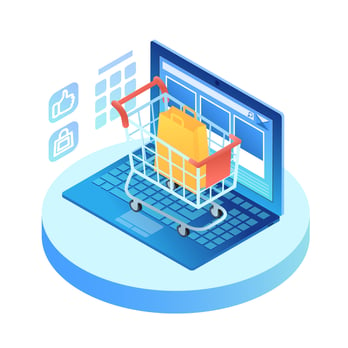21+ Omnichannel marketing statistics to drive your e-commerce strategy
Did you know that brands with a strong omnichannel customer engagement strategy can retain nearly 89% of their customers compared to those with weak omnichannel strategies?
Having an offline store only today is no longer enough. Customers, all over the world, are now accustomed to buying products online.
Sure, they may prefer to see some products in-store, but e-commerce is going to continue growing in the years to come.
This means if you want long-term success, you need to have and use omnichannel marketing. Moreover, your marketing efforts should include creating a unique and consistent omnichannel experience for your customers.
Omnichannel isn’t something you start from day 1 but it should be in and part of your growth plans.
But what is an omnichannel customer experience exactly? And what omnichannel marketing statistics support these claims?
And how can you as an e-commerce store improve your omnichannel experience?
We’ll be answering all these questions (and more!) in this blog post.
What is an omnichannel customer experience?
Omnichannel is the concept of being present wherever your customers are. This usually means having your products and services available via an in-store location, an e-commerce website, and a mobile app.
That said, omnichannel can also extend to creating experiences via tablets and Apple watches. Wherever your customers are.
Here’s a rounded definition of omnichannel via HubSpot:
“Omnichannel is a lead nurturing and user engagement approach in which a company gives access to their products, offers, and support services to customers or prospects on all channels, platforms, and devices.”
Creating an omnichannel customer experience also involves creating relevant messaging across these platforms and locations.
It also means having your marketing, sales, and customer service teams present across all your channels, creating a unified customer experience.
Omnichannel vs multi-channel
Two often confused elements of online marketing are multichannel and omnichannel. And they are quite similar but their results can be significantly different.
Both multi-channel and omnichannel marketing involve creating content across ‘several’ channels. However, the strategic difference between them is that with multi-channel there’s no integration or harmony in messaging between the channels.
Omnichannel, on the other hand, offers that harmony and integration. The brand messaging is not only similar and consistent but it also focuses on how each channel functions.
With omnichannel marketing, the customer enjoys a smooth and consistent experience wherever they interact with a brand.
In multi-channel, they don’t.
Omnichannel marketing statistics
In e-commerce, marketing and customer experience go hand-in-hand. If you want a successful business with repeat customers, then ensuring a smooth and personalized customer experience backed by creative marketing is the way to go.
First, we’ll be looking statistics related to omnichannel marketing.
Omnichannel marketing statistics show you what others have tried and the results they’ve seen through their trial and error.
In other words, they’re saving you time – and a significant amount of money. Still, every e-commerce business is unique. So, there will be some A/B testing on your end but at least you’ll know where to start.

Let’s look at what the following omnichannel marketing statistics have to say. The next section focuses on omnichannel customer experience statistics.
- Having a strong and well-thought-out omnichannel customer engagement strategy can translate into a higher retention rate. Businesses with a strong omnichannel marketing strategy succeed in retaining 89% of their customers to compared to companies with weak strategies that only retain 33% of customers. (Invesp)
- 73% of 46,000 customers buy their products online using more than one channel. (Harvard Business Review)
- 62% of customers who engaged with their favorite brands across “10 or more channels” said they bought products from those brands at least once per week. Moreover, 49% reported making online purchases from those brands. (Fluent)
- Nearly 87% of retailers agree that having an omnichannel marketing strategy is “critical” or “very important” to their success. (Brightpearl)
- “42% of retail executives spend up to half of their marketing budget on omnichannel initiatives.” (Iterable)
- Nearly 56% of every dollar a customer spend inside your physical store is due to or “influenced by” digital transactions. (Deloitte)
- Businesses that ran marketing campaigns via 3 or more channels enjoyed a 287% higher purchase rate than those than ran campaigns via a single channel. (Omnisend, 2020)
- Omnichannel marketing translates to a 250% higher purchase frequency and 13% higher average order value than single channel marketing. (Omnisend, 2020)
- Brands that conduct omnichannel marketing enjoy a 90% higher retention rate compared to those that rely on a single channel. (Omnisend, 2020)
- Consumers who make purchases via multiple channels have a 30% higher customer lifetime value (CLV). (Think With Google/Ipsos)
- Consumers who research products online and in advance are more likely to increase their spending by 13%. (Shopify)
- Brands with omnichannel marketing strategies “drive an 80% higher rate of incremental store visits.” Moreover, 74% of customers conduct online research before visiting a physical retail store. (Think With Google/Ipsos)
- 59% of customers say “being able to shop on mobile is important” to them when deciding which brand or retailer to buy from. (Think With Google/Ipsos)
- Brands using omnichannel marketing enjoy 23x higher customer satisfaction rates than those who don’t. (Aberdeen Group)
Omnichannel customer experience statistics
Your customer experience is an essential element in your broader omnichannel marketing strategy.
In this section, we’ll focus on omnichannel customer experience statistics to see what other businesses have experiences and their take on it.
Whether you’re the business owner or marketing manager, it’s best to look at omnichannel marketing and customer experience through statistics.
- 47% of customers said they’d switch to a competitor “within a day” if they get a poor customer experience. (247.ai)
- 45% of consumers said retailers weren’t “delivering multichannel experiences fast enough.” (McKinsey)
- 90% of customers expect to receive a consistent interaction with customer support via multiple channels. (Forbes)

- Customers who were part of an omnichannel customer experience spent “an average 4% more on every shopping occasion” in-store and up to “10% more online” compared to “single-channel customers.” And with every additional channel these customers used, they “spent more money in the store.” (Harvard Business Review: A Study of 46,000 Shoppers)
- 53% of customers say “their shopping experience would be better if a retailer’s loyalty or rewards program activated automatically at checkout. (Think With Google/Ipsos)
- 51% of businesses use “at least 8 channels” to engage with their customers. (Aberdeen Group)
Omnichannel marketing statistics: The mobile experience
Mobile experiences play a large part in your omnichannel marketing strategy.
In fact, post pandemic and the rising number of Gen Z users and customers, means mobile experiences can significantly boost your revenues and customer numbers.
Here’s what the stats have to say:
- 59% of shoppers said that being able to shop via mobile was a deciding factor for them when buying from a retailer. (Think With Google/Ipsos)
- 56% of customers used their smartphones to research items while they were in a physical store. (Think With Google/Ipsos)
- Omnichannel marketing campaigns that involved SMS marketing “were 429% more likely to end in a conversion compared to single channel campaigns.” (Omnisend, 2022)
Benefits of omnichannel marketing for your store
You’re probably wondering: How does creating an omnichannel experience benefit my online store? And that’s a great question!
Here’s how:
-
Omnichannel means more reach and customers
One of the benefits of using omnichannel marketing as part of your e-commerce marketing strategy is reaching more customers.

Your current customers don’t have to search to find you. At the same time, you can create and reach more lookalike audiences through omnichannel marketing.
With omnichannel, your products and customer support team are a click or an email away.
Further reading: Omnichannel E-commerce: How to Meet the Demands of Dynamic Shoppers
-
Omnichannel translates to higher revenues
Being present in multiple locations means it’s easier for your customers to reach you, get quick replies, and complete purchases faster. This means higher revenues and profits for you.
Moreover, creating an omnichannel experience means your products are available in multiple locations, that is online, offline, social, and mobile.
This can translate into better and more effective retargeting strategies.
Further reading: The E-commerce Retargeting Guide: How to Retarget on Ecommerce Platforms for Maximum ROI
Bonus tip: If you’re using Convertedin’s customer segmentation and ads automation feature, you can target customers where they are more likely to make a purchase. This means a higher value for your return on ad spend (ROAS).
-
Omnichannel means lower CAC
A higher ROAS means a lower customer acquisition cost (CAC), which translates into a better bottom line for your business.
-
Omnichannel means better customer experiences
Customers are constantly looking for new experiences. Online shopping is no exception. But sometimes they want that extra push. That’s where omnichannel comes in.
It keeps your brand top-of-mind for your customers and ensures you’re there when they’re ready to buy. It also provides them with a better buying experience, which increases their satisfaction.
-
Omnichannel creates retention
Having satisfied customers presents an opportunity to build loyal and retention and grow your sales and revenues.
And it’s widely known that in e-commerce, a 5% increase in loyal customers can boost your profits by as much as 25% to 95% compared to acquiring new customers.
5 ways to improve your omnichannel customer experience
As an e-commerce business, your customers’ experiences with your brand play a major role in whether they decide to buy from you or not.
Naturally, you want to improve your customers’ experiences so they can become loyal customers, buy more from you, and refer you to others.
Here are 5 ways to improve your omnichannel customer experience and increase loyalty:
1. Analyze your content and how it works
What drives your customers engage with you? Your marketing strategies, sure, but what makes up your strategy? Essentially, it’s your content.
So, if you want to improve your omnichannel customer experience, then you’ll need to ensure your content is:
- Accurate
- Engaging
- Offers value
- Helps customers
This also includes making sure your business information including contact numbers, email, and other access across social is working and that your team is responsive.
2. Improve your digital capabilities with automation
To ensure your omnichannel marketing efforts and strategy are effective, you need to analyze your digital capabilities and use automation.

There several forms or categories that fall under e-commerce marketing automation. This can include SMS marketing automation, social media automation, ads automation, and more.
3. Create a smoother brand experience
As mentioned in the omnichannel marketing statistics above, customers expect to a unified experience from the same brand regardless of the channel they’re using.
Losing this sense of a unified experience puts customers on edge. Make sure your customer data is unified and connected across all your teams. That way once a customer contacts customer service, regardless of who is answering the query or phone, they can access the customer’s problems and create a seamless experience for them.
In addition, when posting to social, make sure your messaging is the same. Customers will feel rattled if they have different experiences from the same brand.
4. Map your customer journey
One of the reasons you’re conducting omnichannel marketing is to improve your customer experience. Accordingly, you should clearly understand your customers’ journey so you can improve their experience.
By mapping out your customer journey, you can tailor your content, advertising, and services to their needs. Doing so also helps you stay ahead of retail marketing trends and changes in customer behavior.
Moreover, mapping out your customers’ journey helps you:
- Understand your customers better
- Identify the top types of customers that come to your store across your different channels
- Identify where you encounter difficult customers the most
- Identify your best-performing marketing channels
- Get data and analytics about your customers’ habits and patterns
5. Use customer segmentation
Using customer segmentation helps you divide customers into groups so you can target them better and accordingly offer them better experiences.
Segmentation also cuts your customer acquisition costs and increases your e-commerce ROAS and retargeting efforts.
There are 4 main types of customer segmentation: demographic, geographic, behavioral, and psychographic segmentation.
Further reading: Improve Your Facebook ROAS with These 11 Tips
How omnichannel benefits customers
Omnichannel marketing isn’t just helpful for businesses and retailers. Omnichannel benefits customers too.
Here’s how:
- It gives customers the freedom to decide when and where they want to buy your products. For example, stores that offer the buy-online-purchase-in-store (BOPIS) option facilitate pick-up for customers, giving them more control of their time and purchases.
- This means they can make purchases on several channels.
- It allows you to create more personalized experiences which translate into better overall customer experiences.
- Omnichannel marketing – combined with a customer ads and data platform – results in faster resolution of customer queries.
Final words
Creating an omnichannel customer experience is a great way to not only grow your business but also retain and reach more customers.
Reviewing omnichannel marketing and customer experience statistics is a great way to learn from others’ experiences and drive your own.
However, before you rush into creating an omnichannel marketing strategy, you need to assess your business, needs, and budget and how all of these translate into value for you and your customer.
“With multiple approaches and technologies to choose from, and acute margin pressures, retailers can invest in the wrong thing and quickly fall into a downward spiral that can destroy value,” stresses McKinsey in a report.
Build better marketing campaigns with Convertedin, your go-to marketing operating system for e-commerce businesses. Create automated customer-segmented ads that generate better results and reduce your ad spend. Explore Convertedin today!

